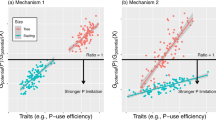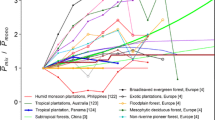Abstract
In the Northern Hemisphere, the surface of south-facing slopes orients toward the sun and thus receives a greater duration and intensity of solar irradiation, resulting in a relatively warmer, drier microclimate and seasonal environmental extremes. This creates potentially detrimental conditions for evergreen plants which must endure the full gamut of conditions. I hypothesize that (1) increased southerly aspect will correlate negatively with evergreen understory plant distributions; (2) derived environmental variables (summer and winter light and heat load) will predict variance in evergreen distributions as well as topographic position (aspect, slope, and elevation) and (3) winter light will best predict evergreen understory plant distributions. In order to test these hypotheses, survey data were collected characterizing 10 evergreen understory herb distributions (presence, abundance, and reproduction) as well as the corresponding topographical information across north- and south-facing slopes in the North Carolina mountains and Georgia piedmont. The best predictive models were selected using AIC, and Bayesian hierarchical generalized linear models were used to estimate the strength of the retained coefficients. As predicted, evergreen understory herbs occurred and reproduced less on south-facing than north-facing slopes, though slope and elevation also had robust predictive power, and both discriminated well between evergreen species. While the landscape variables explained where the plants occurred, winter light and heat load provided the best explanation why they were there. Evergreen plants likely are limited on south-facing slopes by low soil moisture combined with high temperatures in summer and high irradiance combined with lower temperatures in winter. The robust negative response of the understory evergreen herbs to increased winter light also suggested that the winter rather than the summer (or growing season) environment provided the best predictive power for understory evergreen distributions, which has substantive implications for predicting responses to global climate change.


Similar content being viewed by others
References
Ackerly DD, Knight CA, Weiss SB, Barton K, Starmer KP (2002) Leaf size, specific leaf area and microhabitat distribution of chaparral woody plants: contrasting patterns in species level and community level analyses. Oecologia 130:449–457
Adams WW, Demmig-Adams B, Rosenstiel TN, Ebbert V (2001) Dependence of photosynthesis and energy dissipation activity upon growth form and light environment during the winter. Photosynth Res 67:51–62
Adams WW, Zarter CR, Ebbert V, Demmig-Adams B (2004) Photoprotective strategies of overwintering evergreens. Bioscience 54:41–49
Bale CL, Charley JL (1994) The impact of aspect on forest floor characteristics in some eastern Australian sites. For Ecol Manag 67:305–317
Bolstad PV, Swift L, Collins F, Regniere J (1998) Measured and predicted air temperatures at basin to regional scales in the southern Appalachian mountains. Agric For Meteorol 91:161–176
Bolstad PV, Vose JM, McNulty SG (2001) Forest productivity, leaf area, and terrain in southern Appalachian deciduous forests. For Sci 47:419–427
Cantlon JE (1953) Vegetation and microclimates on north and south slopes of Cushetunk Mountain, New Jersey. Ecol Monogr 23:241–270
Desta F, Colbert JJ, Rentch JS, Gottschalk KW (2004) Aspect induced differences in vegetation, soil, and microclimatic characteristics of an Appalachian watershed. Castanea 69:92–108
Fekedulegn D, Hicks RR, Colbert JJ (2003) Influence of topographic aspect, precipitation and drought on radial growth of four major tree species in an Appalachian watershed. For Ecol Manag 177:409–425
Frank EC, Lee R (1966) Potential solar beam irradiation on slopes: tables for 30 to 50 degree latitude. U.S. Department of Agriculture, Forest Service, Rocky Mountain Forest Range Experimental Station Research Paper, RM-18, 116
Galicia L, Lopez-Blanco J, Zarco-Arista AE, Filips V, Garcia-Oliva F (1999) The relationship between solar radiation interception and soil water content in a tropical deciduous forest in Mexico. CATENA 36:153–164
Geiger R (1965) The climate near the ground. Harvard University Press, Cambridge
Givnish TJ, Montgomery RA, Goldstein G (2004) Adaptive radiation of photosynthetic physiology in the Hawaiian lobeliads: light regimes, static light responses, and whole-plant compensation points. Am J Bot 91:228–246
Hicks RR, Frank PS (1984) Relationship of aspect to soil nutrients, species importance and biomass in a forested watershed in West-Virginia. For Ecol Manag 8:281–291
Holst T, Rost J, Mayer H (2005) Net radiation balance for two forested slopes on opposite sides of a valley. Int J Biometeorol 49:275–284
Huebner CD, Randolph JC, Parker GR (1995) Environmental-factors affecting understory diversity in 2nd-growth deciduous forests. Am Midl Nat 134:155–165
Hutchinson GE (1957) Population studies—animal ecology and demography—concluding remarks. Cold Spring Harbor Symp Quant Biol 22:415–427
Hutchinson GE (1959) Homage to Santa-Rosalia; or, why are there so many kinds of animals? Am Nat 93:145–159
Hutchinson TF, Boerner REJ, Iverson LR, Sutherland S, Sutherland EK (1999) Landscape patterns of understory composition and richness across a moisture and nitrogen mineralization gradient in Ohio (USA) Quercus forests. Plant Ecol 144:177–189
Kearney M (2006) Habitat, environment and niche: what are we modelling? Oikos 115:186–191
Lambers H, Chapin FSI, Pons TL (1998) Plant physiological ecology. Springer, New York
Lang GE, Orndorff KA (1983) Surface litter, soil organic matter and the chemistry of minoval soil and follar tissue: landscape patterns in forests located on mountainous terrain in West Virginia. In: Muller RN (ed) Proc. 4th Cent. Hardwood Conf., 8–10 November 1982, Lexington, KY. University of Kentucky, Lexington
Lieffers VJ, Larkin-Lieffers PA (1987) Slope, aspect, and slope position as factors controlling grassland communities in the coulees of the Oldman River, Alberta. Can J Bot—Revue Canadienne De Botanique 65:1371–1378
Lipscomb MV, Nilsen ET (1990) Environmental and physiological factors influencing the natural distribution of evergreen and deciduous ericaceous shrubs on northeast and southwest slopes of the southern Appalachian mountains. 1. Irradiance tolerance. Am J Bot 77:108–115
Logan BA, Grace SC, Adams WW, Demmig-Adams B (1998) Seasonal differences in xanthophyll cycle characteristics and antioxidants in Mahonia repens growing in different light environments. Oecologia 116:9–17
Lunn DJ, Thomas A, Best N, Spiegelhalter D (2000) WinBUGS—a Bayesian modelling framework: concepts, structure, and extensibility. Stat Comput 10:325–337
McCarthy BC, Small CJ, Rubino DL (2001) Composition, structure and dynamics of Dysart Woods, an old-growth mixed mesophytic forest of southeastern Ohio. For Ecol Manag 140:193–213
McCune B, Keon D (2002) Equations for potential annual direct incident radiation and heat load. J Veg Sci 13:603–606
Melillo JM, Aber JD, Muratore JF (1982) Nitrogen and lignin control of hardwood leaf litter decomposition dynamics. Ecology 63:621–626
National Assessment Synthesis Team (2000) Climate change impacts on the United States: the potential consequences of climate variability and change. Cambridge University Press, Cambridge
Neufeld HS, Young DR (2003) Ecophysiology of the herbaceous layer in temperate deciduous forests. In: Gilliam F, Roberts M (eds) The herbaceous layer in forests of eastern North America. Oxford University Press, Oxford, pp 38–90
Olivero AM, Hix DM (1998) Influence of aspect and stand age on ground flora of southeastern Ohio forest ecosystems. Plant Ecol 139:177–187
Pearcy RWRLC, Gross LJ, Mott KA (1994) Photosynthetic utilization of sunflecks: a temporary patchy resource on a time scale of seconds to minutes. In: Caldwell MM, Pearcy RW (eds) Exploitation of environmental heterogeneity by plants. Academic Press, San Diego, pp 175–208
R Development Core Team (2005) R: a language and environment for statistical computing. R Foundation for Statistical Computing, Vienna. http://www.R-project.org. Accessed 2007
Radcliffe JE, Lefever KR (1981) Aspect influences on pasture microclimate at Coopers Creek, North-Canterbury. NZ J Agric Res 24:55–66
Raven JA (1989) Fight or flight: the economics of repair and avoidance of photoinhibition. Funct Ecol 3:5–19
Reich PB, Wright IJ, Cavender-Bares J, Craine JM, Oleksyn J, Westoby M, Walters MB (2003) The evolution of plant functional variation: traits, spectra, and strategies. Int J Plant Sci 164:S143–S164
Rosenberg NJ, Blad BL, Verma SB (1983) Microclimate-the biological environment. John Wiley and Sons, Inc., New York
Searcy KB, Wilson BF, Fownes JH (2003) Influence of bedrock and aspect on soils and plant distribution in the Holyoke Range, Massachusetts. J Torrey Bot Soc 130:158–169
Shanks RE, Norris FH (1950) Microclimatic variation in a small valley in eastern Tennessee. Ecology 31:532–539
Small CJ, McCarthy BC (2002) Spatial and temporal variation in the response of understory vegetation to disturbance in a central Appalachian oak forest. J Torrey Bot Soc 129:136–153
Smith JMB (1977) Vegetation and microclimate of east-facing and west-facing slopes in grasslands of Mt Wilhelm, Papua New-Guinea. J Ecol 65:39–53
Sternberg M, Shoshany M (2001) Influence of slope aspect on Mediterranean woody formations: comparison of a semiarid and an arid site in Israel. Ecol Res 16:335–345
Swartzman GC, Huang C, Kaluzny S (1992) Spatial analysis of Bering Sea groundfish survey data using generalized additive models. Can J Fish Aquat Sci 49:1366–1378
Swift LW Jr, Cunningham GB, Douglas JE (1988) Climatology and hydrology. In: Swank WT, Crossley DA Jr (eds) Forest hydrology and ecology at Coweeta. Springer-Verlag, Berlin
USDA NRCS (2008) The PLANTS Database. http://plants.usda.gov. Accessed 2007
Valverde T, Silvertown J (1997) A metapopulation model for Primula vulgaris, a temperate forest understorey herb. J Ecol 85:193–210
Verhoeven AS, Adams WW, Demmig-Adams B (1999) The xanthophyll cycle and acclimation of Pinus ponderosa and Malva neglecta to winter stress. Oecologia 118:277–287
Weltzin JF, Loik ME, Schwinning S, Williams DG, Fay PA, Haddad BM, Harte J, Huxman TE, Knapp AK, Lin GH, Pockman WT, Shaw MR, Small EE, Smith MD, Smith SD, Tissue DT, Zak JC (2003) Assessing the response of terrestrial ecosystems to potential changes in precipitation. Bioscience 53:941–952
Wentz FJ, Ricciardulli L, Hilburn K, Mears C (2007) How much more rain will global warming bring? Science 317:233–235
Werling JA, Tajchman SJ (1984) Soil thermal and moisture regimes on forested slopes of an Appalachian watershed. For Ecol Manag 7:297–310
Whittaker RH (1956) Vegetation of the great smoky mountains. Ecol Monogr 26:1–69
Whittaker RH, Niering WA (1975) Vegetation of the Santa Catalina Mountains, Arizona. V. Biomass, production, and diversity along the elevation gradient. Ecology 56:771–790
Zhang XB, Zwiers FW, Hegerl GC, Lambert FH, Gillett NP, Solomon S, Stott PA, Nozawa T (2007) Detection of human influence on twentieth-century precipitation trends. Nature 448:461–465
Acknowledgements
This research was supported by NSF grants to H. Ronald Pulliam (DEB-0235371) and to the Coweeta LTER program (DEB-9632854 and DEB-0218001). Research was conducted at the Coweeta Hydrological Laboratory near Otto, NC, and at WHF, University of Georgia property managed by the D. B. Warnell School of Forest Resources. The author gratefully acknowledges the staff and administrators for access to the properties and for logistical support, particularly Brian Kloeppel (Coweeta) and Mike Hunter (WHF). The author also thanks Mary Schultz for field assistance and H. Ronald Pulliam, Lisa Donovan, Ron Hendrick Jr., Marc van Iersel, Mark Bradford, and two anonymous reviewers for manuscript critiques.
Author information
Authors and Affiliations
Corresponding author
Rights and permissions
About this article
Cite this article
Warren, R.J. Mechanisms driving understory evergreen herb distributions across slope aspects: as derived from landscape position. Plant Ecol 198, 297–308 (2008). https://doi.org/10.1007/s11258-008-9406-1
Received:
Accepted:
Published:
Issue Date:
DOI: https://doi.org/10.1007/s11258-008-9406-1




